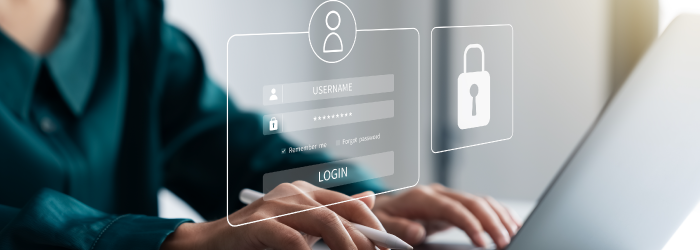
Technology makes running a business easier than ever, but it also opens the door to cyber threats like malware, hackers, and scams. But you can take steps to protect your business and avoid becoming a victim.
Let’s dive into preventing fraud at work and keep your company’s data, finances, and reputation safe.
- Recognize Common Types of Fraud
- Strengthen Your Workplace Cybersecurity
- What to do if You are Targeted by Fraud
1. Recognize the Most Common Types of Business Fraud
Understanding the most common scams is the first step in protecting your business. Here are some of the biggest threats:
Phishing Attacks
Phishing emails look like they come from a trusted source (a bank, vendor, or even your boss) but contain malicious links or requests for sensitive information.
How to Spot It:
- Urgent messages demanding immediate action.
- Scammers impersonate executives using slightly altered email addresses (e.g., ceo@yourcomp4ny.com instead of ceo@yourcompany.com).
- Unexpected attachments or links.
- Poor grammar or slight misspellings in email addresses.
How to Prevent It:
- Never click links or download attachments from unknown senders.
- Always verify directly with the person or company through a separate, official contact method.
- Use email security filters to flag suspicious emails.
Real-World Scenario:
Sarah, the office manager at a small marketing firm, receives an urgent email from her CEO:
“Sarah, I’m in a meeting and need you to wire $10,000 to this vendor immediately. Please handle it ASAP — this is critical. Here are the bank details [Scammer’s Account]. Let me know when it’s done. Thanks!”
The email looks legit — it uses the CEO’s name, email signature, and even the company’s logo. Wanting to follow orders quickly, Sarah wires the money… only to realize later that her CEO never sent the email. The company just lost $10,000.
Malware & Ransomware
Malware (malicious software) can be installed on your company’s computers through fake downloads, unsafe websites, or infected email attachments. Ransomware, a type of malware, locks your data and demands a ransom to restore access.
How It Happens:
- Scammer spoofs a trusted vendor’s email to send malware-infected attachments.
- Opening a file installs ransomware, which locks down the computer system.
- Hackers demand a ransom to unlock company data — often with no guarantee they’ll actually restore access.
How to Prevent It:
- Use strong antivirus software and keep it updated.
- Avoid downloading software from unknown sources.
- Train employees to recognize suspicious links and attachments.
- Back up your data regularly so you can restore files without paying a ransom.
Real-World Scenario:
Mark, the accountant at a small construction company, receives an email from a trusted supplier with an attached invoice. The email says:
“Hey Mark, here’s the invoice for last month’s materials. Please review and send payment.”
Mark opens the attachment — and nothing happens. Moments later, his computer screen goes black. A message appears:
“Your files have been encrypted. Pay $50,000 in Bitcoin within 48 hours, or your data will be permanently deleted.”
Mark realizes that his entire network is locked — customer records, payroll files, everything. His company is now at the mercy of cybercriminals.
Payment & Invoice Scams
Scammers might pose as vendors, suppliers, or even employees to trick businesses into sending payments to fraudulent accounts. Business email compromise (BEC) fraud alone cost companies over $2.7 billion in 2023.
How It Happens:
- Scammers hack a supplier’s email account or pretend to be a vendor.
- They send fake messages with the new bank details for invoice payments.
- Once the payment is sent, it’s transferred overseas or withdrawn immediately.
How to Protect Your Business:
- Verify all payment requests, especially if details like bank accounts have changed.
- Use two-factor authentication (2FA) for financial transactions.
- Monitor bank statements and financial records for any unusual activity.
2. Strengthen Your Workplace Cybersecurity
Now that you know the risks, let’s talk about how to build a fraud-resistant workplace.
Implement Strong Password Practices
Weak passwords are like leaving the front door open for hackers. 80% of data breaches happen due to weak or reused passwords.
- Require unique, complex passwords for every account. Complex passwords are long (ideally 16+ characters), use a combination of uppercase and lowercase letters, numbers, and symbols.
- Use multi-factor authentication (MFA) for extra security.
- Encourage the use of password managers to keep login details safe.
Train Employees on Cybersecurity
Your employees are your first line of defense against fraud. Educate them on how to recognize scams and what to do if something seems suspicious.
Pro Tip: Schedule cybersecurity training at least once a year.
Teach employees:
- How to spot phishing emails
- Why they shouldn’t use personal devices for work
- What to do if they accidentally click a suspicious link
Want to test your workplace security knowledge? Take our free Workplace Cybersecurity Quiz here:
Secure Your Business Devices & Network
Many cyberattacks happen because businesses fail to secure their networks and devices. Here’s how to prevent that:
- Keep software & security patches updated — hackers exploit outdated systems.
- Limit employee access — only give access to the systems/data employees need.
- Use secure Wi-Fi networks — avoid public Wi-Fi for business operations.
Pro Tip: Set up automatic updates for all work devices so security patches are always current.
3. What to Do If Your Business Is Targeted by Fraud
Even with strong protections in place, fraud attempts can still happen. Acting quickly can reduce damage and recover losses.
- If you receive a suspicious email: Report it to your IT team immediately.
- If you suspect malware or a data breach: Disconnect affected computers from the network and contact cybersecurity professionals.
- If money was sent to a scammer: Notify your bank ASAP and report the fraud to the FBI’s Internet Crime Complaint Center (IC3) at ic3.gov.
MidWestOne Bank is here to help protect your business. If you’re worried about fraud risks, talk to business relationship manager about secure business banking solutions that can help safeguard your accounts.
Keep Your Business Safe from Fraud — Start Today
Protecting your business from fraud doesn’t have to be overwhelming. By staying informed and taking proactive steps, you can reduce your risk and keep your workplace secure.
MidWestOne Bank is committed to helping small businesses succeed — let’s work together to keep your company safe from fraud!


You are now leaving MidWestOne Bank.
We have provided this link for your convenience and are not responsible for the content, links, privacy policy, or security policy of this website.
Email is not a secure method of data transfer. Personal and confidential information should not be sent via email. Please contact MidWestOne Bank if you need to provide confidential information.
Would you like to continue?
Continue to Email?
Yes, Continue No, Cancel